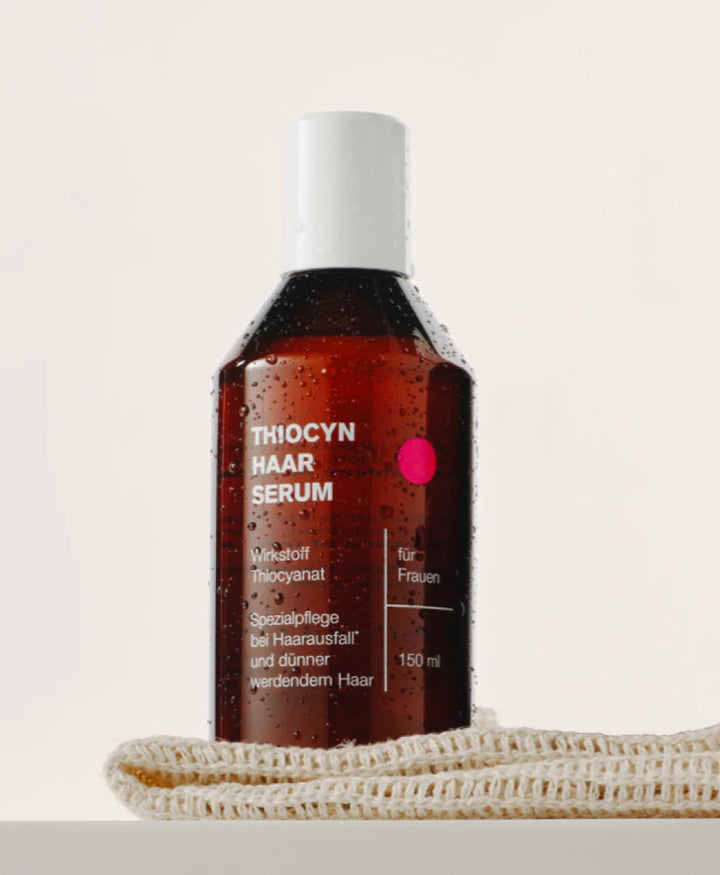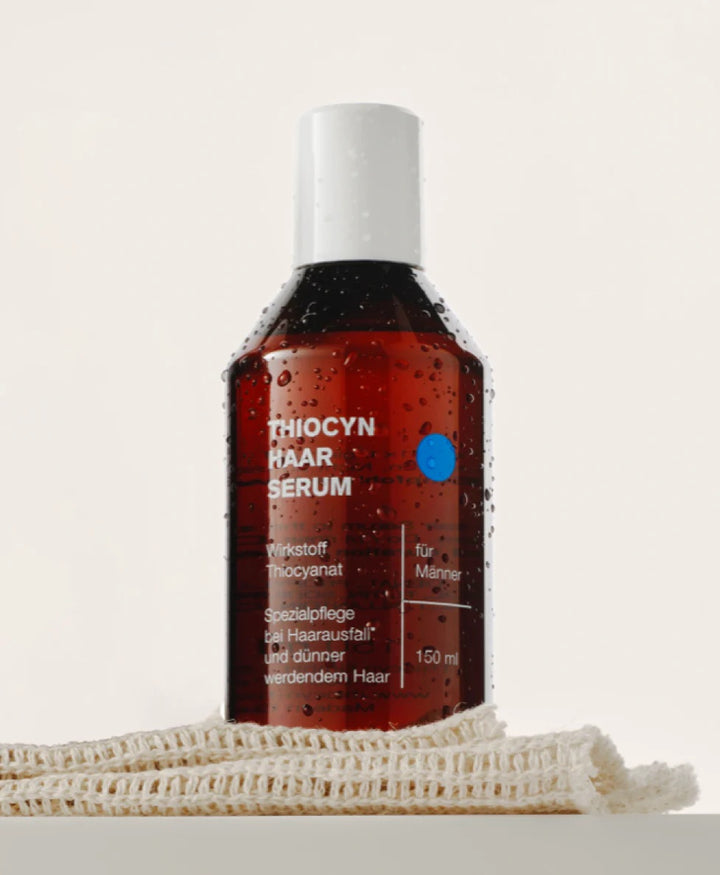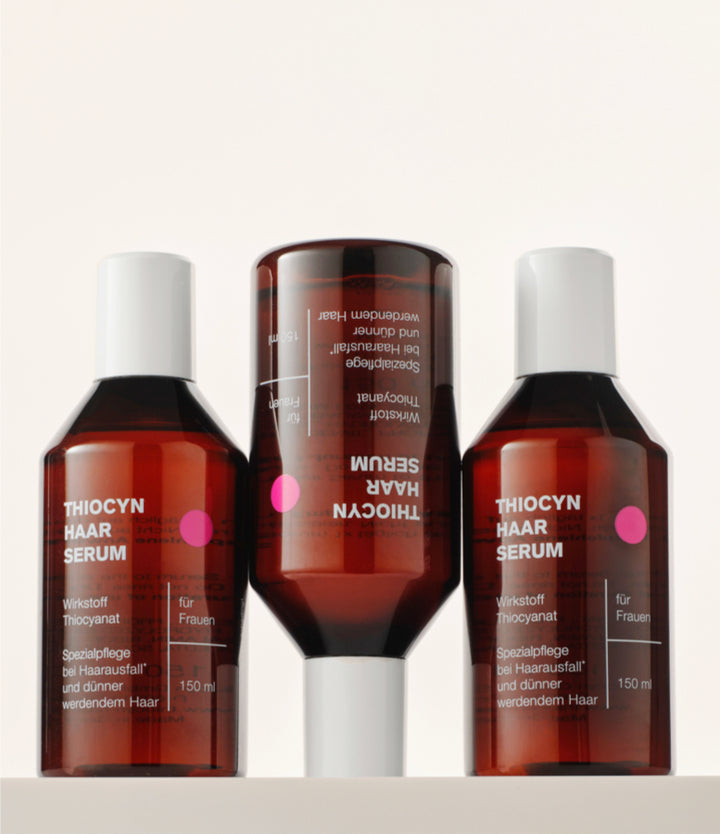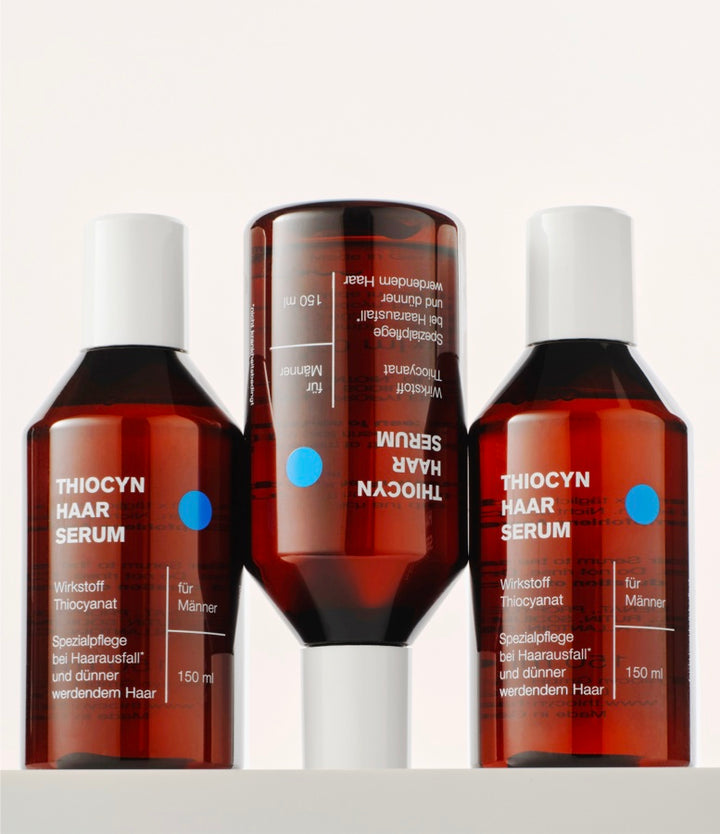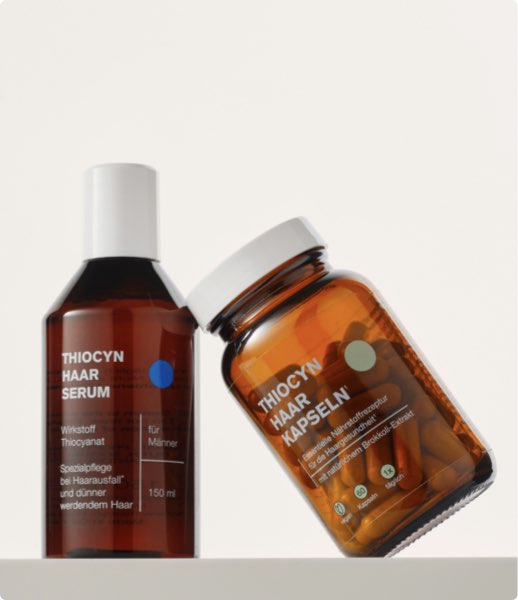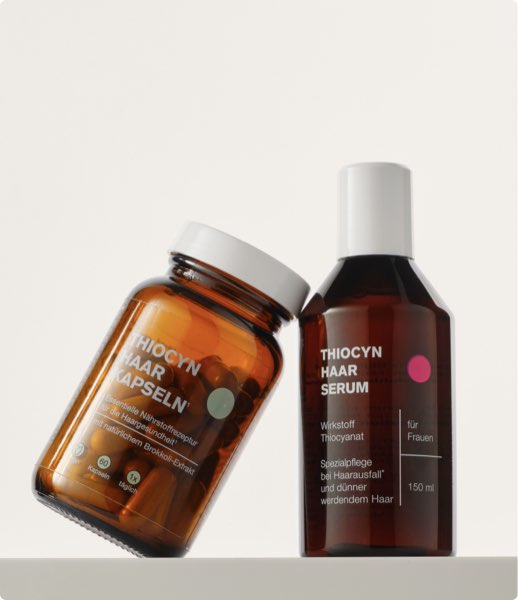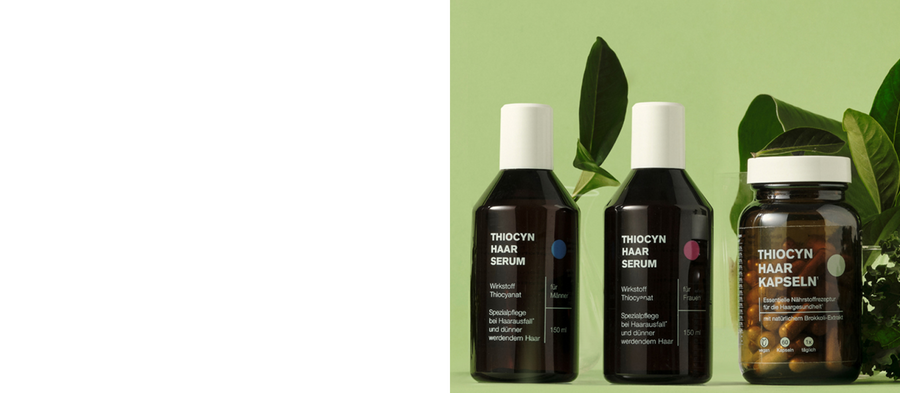| 04. July 2023
Thin hair? Fine hair?

- The ideal of many women: a beautiful mane.
- Decreasing hair density and thin hair stand in the way of this wish.
- Thin hair is a result of excessive hair loss, but also fatigue of the hair follicles.
- Styling and volume tips only help to a certain extent.
Thin hair? There comes a point where women with thin hair, or more specifically, thinning hair, no longer want to experiment with new hairstyles, a new hair color, or volumizing shampoo. Because hair care and styling cover up a lot of things, but they don't prevent hair loss, the miniaturization of hair, and the unmistakable feeling that more and more hair is falling out than growing back. Is it possible to counteract this?
What is thin hair?
Thin hair means that the number or density of hair on the head is decreasing. The hair gradually becomes less full and less voluminous. The hair becomes thinner.
Thin hair or fine hair?
Thin hair is not fine hair. Fine hair refers to the diameter of a single hair. Fine hair is defined as having a diameter of 0.03 to 0.05 mm. Hair is considered thick from 0.08 mm. Thickening fine hair is possible to a certain extent with care products that create a protective film, such as silk proteins, around each fine hair.
Causes of thin hair
If hair density decreases, it's advisable to consult a doctor. Dermatologists often diagnose diffuse hair loss or androgenetic alopecia, or hereditary hair loss. Age also has its toll. All body organs find it harder to regenerate after the age of 30. Hair follicles also age.
1. Diffuse hair loss – all over the head
Diffuse hair loss occurs when more than 100 hairs fall out daily over a longer period of time. Causes of hair loss in women Hormonal changes or iron deficiency may be considered; in women and men: medication side effects, thyroid disorders, feverish infections, scalp diseases, an unbalanced diet, or metabolic disorders. Last but not least, stress can lead to patchy hair loss in those affected.
2. Hereditary hair loss
Hereditary hair loss is easily identified by the pattern of hair loss. Men see a receding hairline developing above their temples; a tonsure develops at the back of the head. Starting in their mid-30s, men's hair begins to thin on top of the head. When the hair loss zones merge, a bald head develops. In women, hereditary hair loss is triggered around the age of 50 with the onset of menopause. Gradual hair loss occurs in the crown area.
Both men and women are affected by decreasing hair density because genetically misprogrammed hair follicles are sensitive to a derivative of the sex hormone testosterone, dihydrotestosterone (DHT). This has two consequences:
Miniaturization of hair, downy hairs
New hairs no longer grow as vigorously. Instead of "normal" terminal hairs, numerous colorless and, above all, thinner downy hairs become visible. Downy hairs grow to a maximum of only 1 cm long and 0.04 mm thick; they become miniaturized, so to speak. And they disappear completely when the hair follicles stop functioning.
Decreasing hair density, thinning hair
The ongoing process of miniaturization leads to a decline in hair density. Shorter hair cycles combined with premature hair loss lead to thinning and sparse hair.
3. Hair follicle fatigue
Another reason for hair thinning is increasing age. As we age, hair follicles find it increasingly difficult to cope with harmful metabolic byproducts, such as oxygen radicals. After hair loss, the hair follicles typically go through a resting phase of two to three months before a new hair cycle begins. From the age of 50, the regeneration phases can extend to four, five, or even six months.
Psychological consequences of hair loss and thin hair
Men and women react to hair loss very differently. We can say that young men certainly suffer more from hair loss than older men, who eventually come to terms with their hereditary hair loss. This is probably also due to the high level of social acceptance: Men and hair loss somehow belong together.
In general, however, it can be said that men with short, remaining hair or a bald head are readily considered attractive. Hair loss and thinning hair in women, on the other hand, completely challenges their self-image. Women define themselves by beautiful, strong, healthy hair. Their ideal: a mane.
The best tips for thin hair
Our tips: Don't over-stress your hair when caring for and styling it, and above all, support healthy hair growth.
Want more volume with hot air? Even better: increase hair density.
1. The right hairstyle
A good cut makes thin hair appear fuller and more beautiful. A hairdresser will always advise women with thin and fine hair to go for a shorter cut and, above all, recommend the right hair care products to ensure that the cut and hairstyle look their best.
When women are dissatisfied with the quality of their hair or their hairstyles, it's often due to using the wrong care products. For example, women with fine hair often turn to products for structurally damaged hair. These ingredients coat the hair to conceal damage to its outer layer. Fine hair but are weighed down and hang down instead of building volume.
2. Protect your scalp
When it comes to hair loss, gentle hair care is especially important. The biggest problem with washing your hair isn't the effect of shampoo on the hair itself, but rather on the hair roots in the scalp.
While washing your hair cleanses it of sebum, skin particles, body salts, and environmental influences, every wash also puts a strain on your scalp. Therefore, a mild shampoo is best for scalp care. Caring for fine hair presents a particular challenge, as fine hair tends to lie flat against the scalp and tends to get greasy more quickly.
A largely unknown hair problem is the fact that every time you wash your hair, an important molecule in the body that promotes hair regeneration is washed out. This molecule is called thiocyanate. noreiz Skin Soothing Care Shampoo thoroughly cleanses the scalp and hair and provides thiocyanate.
3. The right diet
Our diet should provide the body, especially the hair's cellular metabolism, with everything it needs: energy (carbohydrates), building blocks (proteins that turn into keratin), and, last but not least, functional substances such as vitamins, such as biotin, and trace elements such as iron or thiocyanate, which is found in dairy products, broccoli, cashews, and cress. Dietary supplements can compensate for certain deficiencies.
Often neglected when optimizing your diet: adequate water intake. Every substance essential for cell division and growth of hair cells can only reach the hair or hair follicles via the bloodstream when dissolved in water. The right amount of water varies from person to person and ranges between 1.5 and 2 liters per day.
4. Active ingredient against thin hair: Thiocyanate
Thiocyanate is a natural molecule that, like water, has accompanied the development of life from the very beginning and is therefore of great importance to the human organism – for cellular metabolism, including at the hair roots, where hair is formed. Thiocyanate has a cell-stabilizing and antioxidant effect on the hair-forming cells. Hair growth is naturally stimulated.
As part of a balanced diet, we consume thiocyanate through dairy products, many types of cabbage such as broccoli, sweet potatoes, cashews, and cress. If we lack thiocyanate, we can supplement it externally.
With the patented thiocyanate active formula in Thiocyn Hair Serum, it is possible to strengthen the hair roots from the outside, protect them from growth-disrupting influences, and normalize the hair cycle of regrowing hair.
Under optimal conditions, the thinning hair becomes thicker again. In a clinical dermatological application test over a period of 36 weeks, the majority of subjects reported less hair loss and significantly thicker hair.
By the way: Since products that stop thinning hair due to androgenetic hair loss should be used permanently, it is especially important for women that these products do not interfere with hormonally controlled metabolic processes.
Frequently asked questions to our service team
Do I have fine hair or thin hair?
"Fine hair" refers to the diameter of a hair. Fine hair has a diameter of around 0.05 mm. Thick hair is defined as 0.08 mm or larger.
The term "thin hair" refers to the hair density per square centimeter. We have the greatest hair density at a young age. The thicker the hair and the denser the hair coat, the greater the hair volume.
My hair is thinning, but I'm not losing hair...
You're probably suffering from hereditary hair loss. This doesn't mean you have to experience excessive, noticeable hair loss—with more than 100 hairs lost per day for many weeks or months. The real problem is gradual hair loss: When the hair follicles prolong their regeneration phase, become miniaturized, or stop working, hair density decreases.
If the hair thins over the temples (receding hairline) and/or at the back of the head (tonsure), this is an indication of hereditary hair loss of the male pattern. Women with hereditary hair loss are affected by thinning hair in the crown area.
Why is my hair getting thinner?
If the hair thins out all over your head and the hair volume or density decreases, it is likely that you are suffering from diffuse hair loss Possible triggers include stress, feverish infections, iron deficiency, metabolic disorders, or side effects of medications; combinations cannot be ruled out.
Diffuse hair loss is generally reversible if the underlying cause is eliminated or treated. Very fine, sometimes downy hair is generally a good sign, as it indicates the beginning of a new hair cycle.
Can you measure thin hair?
Yes. However, thin hair is a relative value – it depends on hair color. For example, blond-haired people – both men and women – have an average of 150,000 hairs, black-haired people around 110,000, brunettes over 100,000, and redheads over 75,000. If a red-haired woman loses an average of 300 hairs per day over a period of three months, she loses almost a third of her hair in 90 days (300 x 90 days = 27,000 hairs). Blonde-haired women would "only" lose a fifth of their hair.
Does dyeing your hair cause hair loss?
More and more women are using tints and hair dyes, not only to cover gray hair, but primarily to alter their natural hair color. For permanent coloring, the hair pigments are oxidized through bleaching. The use of hydrogen peroxide, in particular, can cause skin irritation. Repeated coloring also damages the hair's outer layer. However, coloring procedures do not lead to excessive hair loss.
How often can a hair grow back?
A hair can always grow back, provided its follicle is intact. Average hair growth is about 1 to 1.5 cm per month, or about 12 to 15 cm per year. Depending on genetic predisposition, a hair grows 0.3 mm per day and takes an average of four to five years until its follicles complete their growth phase. In women, hair grows longer—up to eight years—as a result of the "hair growth drug" estrogen.
READ BY 23,000 PEOPLE
Join 23,000 others and find out how to improve your hair health with great offers and discounts as well as helpful advice
